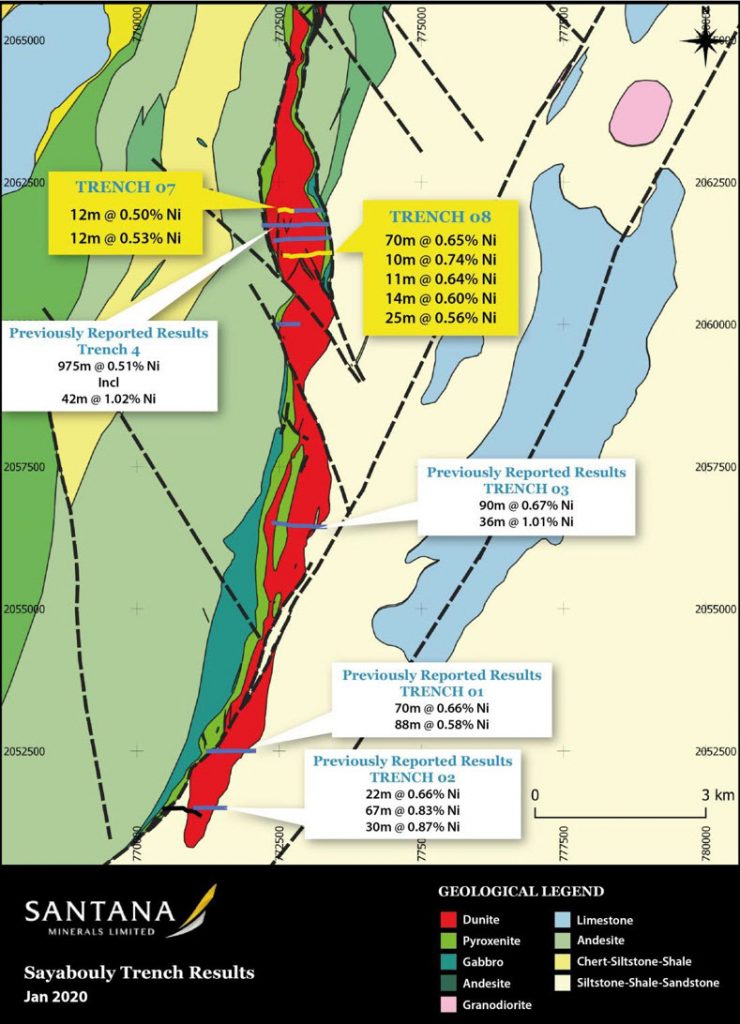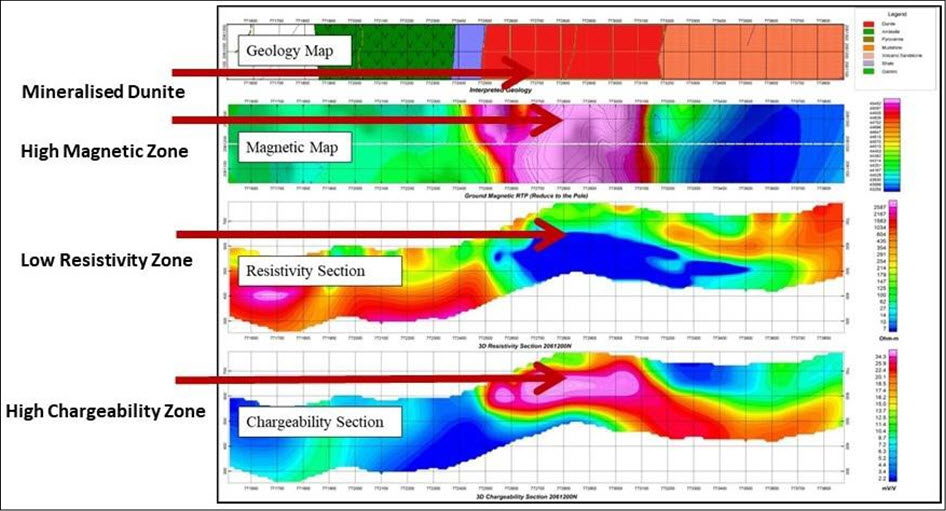Key Highlights:
- Further trench results received gives further evidence of strong near surface nickel mineralisation at the Phu Lon Nickel Prospect.
- Significant results recorded from Trench 8 include:
- 70m @ 0.65% Ni;
- 10m @ 0.74% Ni; and
- 25m @ 0.56% Ni.
- Importantly, Trench 8 was excavated directly above a high chargeable/low resistivity electrical geophysical anomaly are interpreted as a large buried zone of nickel sulphides.
- The new results are close to previous high-grade trench results:
- 975m @ 0.51% Ni (Including 42m @ 1.02% Ni);
- 90m @ 0.67% Ni (including 36m 1.01% Ni); and
- 80m @ 0.74% Ni (including 17m @0.91% Ni).
- Phu Lon has a significant mineralisation footprint confirmed along a 14km strike length, with previously completed petrology identifying nickel sulphide minerals;
- A maiden drilling program at Phu Lon is scheduled to commence on or about 20th January, initially comprising 13 holes for circa 2,000m of diamond drilling with first assays expected in February 2020.
15 January 2020. Santana Minerals Limited (‘Santana’ or ‘the Company’) is pleased to announce results from trenching from the northern section of the Phu Lon Nickel Prospect, located within the Sayabouly Project in Laos.
The results are from trenches 7 and 8 located directly north and south respectively of the previously reported Trench 4, which returned results of 975m @ 0.51% Ni including 42m @1.02% Ni. Trench 7 was an extension to the west of an existing trench, while Trench 8 was excavated along a previously completed line of induced polarisation survey line. This geophysical electrical survey method identified a high chargeability with coincident low resistivity anomaly at this location and is interpreted as a zone of sulphide mineralisation at a depth of approximately 100m (Figure 2).
The significant assays from these 2 additional trenches included:
- 70m @ 0.65% Ni Trench 8;
- 10m @ 0.74% Ni Trench 8;
- 11m @ 0.64% Ni Trench 8;
- 14m @ 0.60% Ni Trench 8;
- 25m @ 0.56% Ni Trench 8;12m @ 0.50% Ni Trench 7; and
- 12m @ 0.53% Ni Trench 7.
These trench results can be seen in context of previously reported trenching results in Figure 1.
Importantly, the trench samples were taken below the lateritic profile from the weathered ultramafic intrusion that hosts the nickel mineralisation. Previously released petrology results (Santana ASX Announcement, 17 July 2019) identified nickel sulphide minerals which strengthened the interpretation of a model based on the large and iconic Jinchuan Nickel Deposit in China (500Mt @ 1.2% Ni, 0.7% Cu and 0.4g/t Platinum group elements). These latest results from the weathered ultramafic further bolsters this model.

The results from Trench 8 are particularly encouraging and strengthen the interpretation that a buried zone of nickel sulphide mineralisation is located approximately 100m below surface. The zone shown in Figure 2 is a key focus for the forthcoming drilling campaign.

These results further highlight the importance of the forthcoming maiden drilling program, scheduled to commence on or around 20th January. The drill program will target bulk tonnage nickel sulphide and will comprise an initial 13 holes for 2,000 diamond drilled metres with first assay results from this program expected in late-February 2020.
This announcement has been authorised for release to the ASX by the CEO. For further information please contact:
Shane Pike – CEO Santana Minerals Limited shane.pike@santanaminerals.com
Cameron Peacock – Investor Relations and Business Development cpeacock@santanaminerals.com
+61 7 3221 7501 or admin@santanaminerals.com
Original Article: http://santanaminerals.com/wp-content/uploads/2020/01/Significant-Trench-Results-from-Sayabouly-Project-Laos.pdf

















